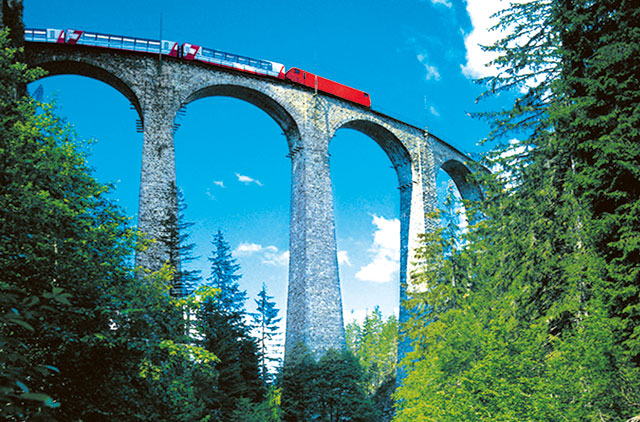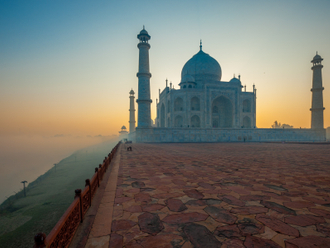Forced to slice through mountains and traverse valleys simply to connect far-flung mountain communities, Switzerland’s engineers created a complex network of enviable rail, road and waterways. As newer, faster routes have replaced early solutions, that legacy infrastructure is now being put to new use by the country’s tourism industry.
In 2016, the $10.3 billion (about Dh37.8 billion) Gotthard Base Tunnel will commence operations, connecting the southern canton of Ticino with Uri in the north. At 59 kilometres, it will be the longest tunnel in the world. But it will also add greater freight capacity between Germany and Italy, as well as reduce travel between Zurich and Milan by more than an hour. Travellers choosing this new, faster route will have to endure a considerable spell of darkness where they can now put high school geography to use identifying Alpine peaks and water bodies on trains such as the Wilhelm Tell Express, which combines a panoramic trans-Apline train journey with a leisurely boat ride. On the ride, you learn about Switzerland’s famous spiral tunnels, or rather more importantly, of how the Swiss federation was founded in Rutli, a meadow off Lake Lucerne.
“In Switzerland, travelling is an adventure,” declares Andreas Nef, Manager, GCC Market, Swiss Travel System. “It isn’t just about getting from one place to another.” Traversing the Alps can mean spending an entire day on a train, but with panoramic coaches and Lavazza-brewed espresso, the Swiss do their best to make these long trips memorable events in themselves.
Next year will see the introduction of a new two-year promotion, the Grand Tour of Switzerland, which combines some of the most glorious crossings into a two-week suggested itinerary that showcases the country’s surprising diversity. Four seasons in one day? That’s entirely possible on a train ride in Switzerland.
Here, then, are four trips where the journey is its own reward:
The Glacier Express
The most famous railway line in the world — and the slowest express train — connects Zermatt in the south to St Moritz in the west. The seven-and-a-half hour journey also connects two of Switzerland’s most well-known mountains: the Matterhorn and Piz Bernina. Having first run in 1930, the metre-gauge train travels about 169 kilometres through 91 tunnels and over 291 bridges. Its huge panoramic windows allow passengers several opportunities to marvel at Swiss ingenuity along the way — as well as to encounter two of Europe’s most famous rivers, the Rhine and the Rhone.
Look out for: Spiral tunnels between Preda and Bergun that raise the line 400 metres, the 400-metre-deep Rhine gorge, the 2,033-metre high Oberalp pass, the chalets of the Goms valley, and the 65-metre-tall curved limestone viaduct spanning the Landwasser river. The trip is best in the winter.
Off the train: Car-free, romantic Zermatt with its thriving rock and jazz scene, and glamorous St Moritz, Audrey Hepburn’s home for several years, are both worth visiting in their own right. The former gets more than two million tourists a year, while the latter is best known for its hectic winter sporting schedule and for its healing waters — stop off at the Kempinski St Moritz Spa for an olde worlde cure.
Nice to know: Since 1981, the train doesn’t pass the Rhone Glacier on the Furka Pass, because bypassing the ice sheet that inspired its name allowed year-round operations.
The Wilhelm Tell Express
Only about 7 per cent of Swiss speak Italian, although it is one of the country’s official languages thanks mainly to the province of Ticino, where the Wilhelm Tell Express begins. Ticino is worth visiting, jokes Michel Cavadini of the local tourism authority, because it’s just like Italy — only everything here actually works. That dual nature is explored on this five-hour route, which combines train and steamboat rides to showcase two of the country’s most stunning cantons. Although the new Gotthard Base Tunnel will slash travel times between the regions in 2016, the Swiss Travel System expects to continue running the Wilhelm Tell experience.
Look out for: The weather. If it’s sunny on one side of the Alps, you can be sure it’s going to be nasty on the other, say locals, and on our journey, we exchanged rainy, Mediterranean Ticino for luminous, beautiful Lucerne. Then there’s the existing 15km-long, 1,100-metre-high Gotthard Tunnel, which took ten years to build and claimed 200 lives, the church of Wassen (three times, each from a different angle), and the mountains Pilatus and Rigi.
Off the boat: Many sights relating to Tell’s life are sited around the lake. The 3,020-metre-tall Mount Titlis, just outside Lucerne, is home to the world’s first revolving cable car and a nerve-jangling cliff walk, while from a point above Locarno in the south, you can see both Switzerland’s highest and lowest points. Also from outside Lucerne, the world’s steepest cogwheel train hugs the side of the Alps for 1,635 metres to Mount Pilatus and its mythical resident dragon.
A weekend in Lugano, called the Monte Carlo of Switzerland for the growing number of celebrities who live here, is easy to tack on — for the laid-back dolce vita, for family attractions such as the Swiss Miniature theme park, or for the vertigo-inducing Monte San Salvatore 360-degree open-air view of the surrounding countryside. The Hotel de La Paix has experience with luxury-loving Dubai residents.
Nice to know: As far back as 1607, scholars questioned whether Wilhelm Tell — he of crossbow and apple fame — was more than a fictional figment. Over the centuries, books disputing his existence have been burnt, but modern historians generally regard his story as little more than a folk fable.
The Golden Pass Line and the Jungfrau Railway
Combining two train rides makes for an all-round experience that spotlights some of the best bits of Switzerland for those with shorter holidays. The Golden Pass Line links the country’s German-speaking centre with its flamboyantt French west. Battles between the two largest linguistic communities are legend, but neither will countenance a split — unlike, of course, the Belgians.
The day begins aboard the spanking new Lucerne-Interlaken Express, which departs from the shores of Lake Lucerne. It then climbs 1,008 metres to the Brunig Pass before descending into Meiringen and Interlaken. From there, it’s easy to switch to the Jungfrau Railway and travel up to the forbidding ice maiden at the top of Europe, the Jungfraujoch, encased in snow all year round and reached via Europe’s highest-altitude railway station, at 3,454 metres. Once you’re ready to move on, take the Golden Pass Line in the other direction: to Montreux, on fabled Lake Geneva. Home of the jazz festival, Freddy Mercury wrote his last album here.
Look out for: The Giessbach Falls, wooden sculptures of endemic (and extinct) animals along the route to Interlaken, the great peaks of the Eiger and the Jungfraujoch in Interlaken, and endless hectares of vineyards that hide one of the country’s great agricultural secrets.
Off the train: The charming mountain village of Grindelwald in the Bernese Highlands boasts a fabulous spa (and halal food) at the Romantik Hotel Schweizerhof, but has attracted visitors in the summer and the winter for over a century. Or channel your inner super spy in Schilthorn, location for the James Bond film On Her Majesty’s Secret Service. The Piz Gloria revolving restaurant (not the actual one in the film) and the new Bond World offer a look-see into its making.
Nice to know: Some 32 Italians died building the Jungfrau Railway. Italians have historically been among the largest expatriate group involved in the construction of Switzerland’s railroads. The English, on the other hand, are most notable for kick-starting winter sports around the country, with village museums explaining how they brought skiing, curling and even egg blowing to Alpine slopes and gymkhanas.
The Chocolate Train
Food tourists will delight in the nearly ten-hour round trip between Montreux and Gruyères, which serves up the two Swiss delicacies in a Bello Epoque environment. From June through October, this 1915 Pullman train makes a round trip across the Switzerland’s French-speaking west, stopping at the medieval cheesemaking town of Gruyères as well as at Broc, home to the Nestle-Cailler chocolate factory.
Look out for: Chocolate at factory prices and seemingly acrobatic cows.
Off the train: Two 1,000-year-old castles on the route should thrill children: the Chateau de Chillon on Lake Geneva, and Gruyeres castle, with its intricately painted walls and fantastic views. Or you can take the truffle-making class at the Cailler facility.
Nice to know: It was at Broc that Alexandre-Louis Cailler, grandson of founder Francois-Louis Cailler, decided to use milk instead of water to make chocolate. Today, milk is indispensable to the standard recipe.







